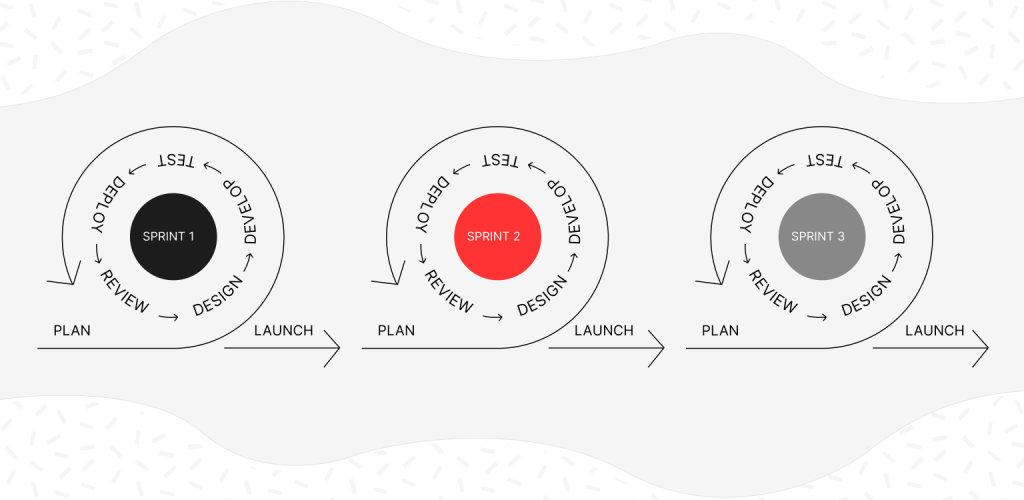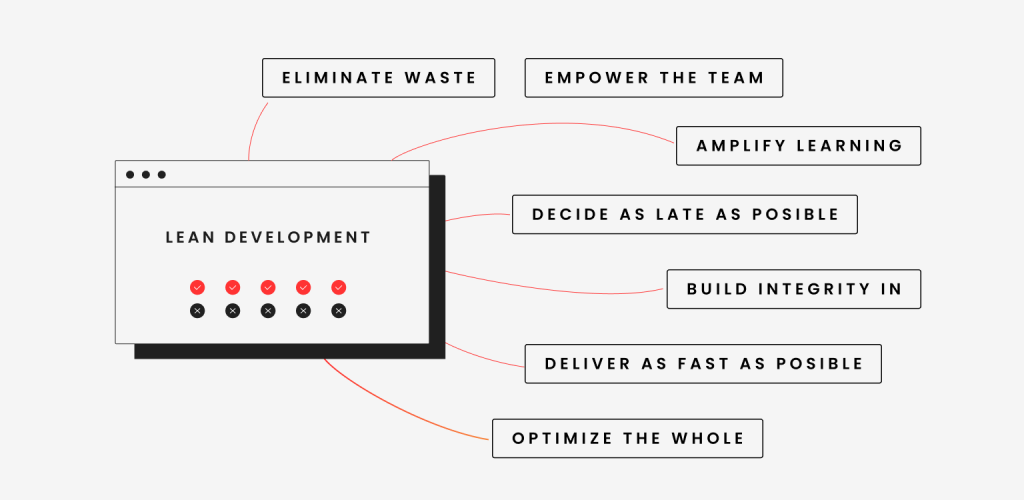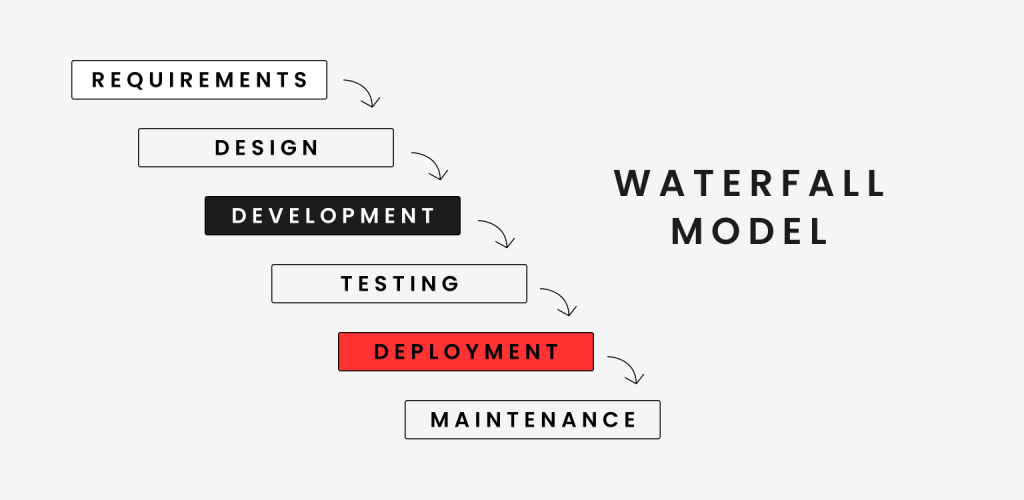Software Development Approaches: Methodologies & Frameworks
Framework and methodology are among the most commonly used terms in the software development industry today. However, despite some considerable differences between the two, a lot of software development professionals use these terms interchangeably. So before we get to describing the most popular software development approaches, let’s learn the important distinctions between a software development methodology and software development framework.
What is a software development methodology?
A methodology is a documented set of conventions that your team follows to systematically solve software development problems. It is a set of software development principles, tools, practices, and predefined rules that can be used to guide your processes in a coherent, consistent, accountable, and repeatable manner. A methodology is a combination of two key things: the methods you’ve chosen to achieve your software development goals and the logic behind those methods. Methodologies are strict and provide clearly defined steps to be taken, including why and how these steps should be accomplished.
What is a software development framework?
On the other hand, there’s a software development framework that provides you with a structured approach to problem solving around which you can build your software development process. It provides a logical structure for classifying and organizing complex work and the structural components you need to implement a model while leaving room for other practices and tools to be included. While some frameworks are rigid, the vast majority is very lenient throughout the software development lifecycle. They provide much room for creativity and can be easily adapted to fit a particular problem.
In a nutshell, a methodology offers a strict, systematic approach to solving a problem, whereas a framework provides a skeletal structure around which you can build your software development process.
Agile software development

Agile software development is more than just a methodology, framework, or set of practices. It is a complex iterative approach to project management and software development that represents a whole umbrella of frameworks and practices based on the values and principles expressed in the Manifesto for Agile Software Development and the Twelve Principles of Agile Software behind it.
The Agile approach helps software development teams focus on delivering work in small, but tangible, increments achieved through continuous evaluation of requirements, plans, and results. This enables great flexibility in responding to change compared to the traditional approaches such as Waterfall which plans every little detail ahead. Such flexibility helps your team figure out a timely solution to every arising issue, the right things to do given your particular context.
One other major thing that separates Agile from other approaches is the focus on efficient collaboration between self-organizing, cross-functional teams within your project. This means that members of your project team don’t necessarily have to have specific roles but rather the required skill sets. This also means that your team members have the ability to figure out how they’re going to approach a certain problem on their own.
Scrum development framework

Scrum is a lightweight agile project management framework that focuses on helping software development teams find adaptive solutions to complex problems. It stimulates productivity and creativity in delivering products by helping teams self-organize while working on a problem, learn through experiences, and continuously improve.
As such, Scrum adopts an evidence-based empirical approach. This means that the team accepts that problems cannot be fully understood or defined up front, and thus, focuses on maximizing the team’s ability to quickly respond to emerging requirements and changes in market conditions.
Scrum is not a methodology. It does not combine a big collection of interwoven mandatory components. In fact, it’s the opposite. Scrum development framework replaces an algorithmic, methodological approach with a heuristic one, where teams self-organize and collaborate closely through daily face-to-face communication to effectively tackle any unpredictable challenges in the course of development.
In short, Scrum works like this:
- A Product Owner orders the work for a complex problem into a Product Backlog.
- The Scrum Team turns a selection of the work into usable components during a Sprint.
- The Scrum Team and product stakeholders analyze the results.
- The Scrum Team adjusts for the next Sprint.
- The whole process repeats.
Lean software development

The concept of Lean software development is, in fact, the adaptation of the manufacturing principles and practices from the Toyota Production System to the domain of software development. Same as in manufacturing, the main objective of this approach in software development is to minimize waste. For that, Lean software development offers a solid conceptual framework with values, principles, and good practices for “removing all things unnecessary” during the software development process.
Its seven principles correspond closely with those of Agile development:
- Eliminate waste
- Amplify learning
- Decide as late as possible
- Deliver as fast as possible
- Empower the team
- Build integrity in
- Optimize the whole
Kanban development method

Just like the Lean approach, Kanban development method also originates from lean manufacturing, inspired by the very same Toyota Production System. Claimed by the software development domain, today Kanban serves as a visual process management system that helps teams define, manage, and improve the workflows on their software development projects.
Kanban development method puts an increased focus on the efficiency of your decision-making process about what, when, and how should be done in the course of software development. It improves the handling of development bottlenecks by helping your team effectively balance the scope of work with available capacity.
The Kanban board visualizes your software development process and progress from start to finish. The complexity of your Kanban system can be anything from the most straightforward, basic columns such as Requested, In Progress, and Done to a combination of a dozen other workflow steps. When built, managed, and functioning correctly, the Kanban system provides your team with real-time information on the general workflow, the progress of individual items, and possible bottlenecks.
Kanban development method is more commonly used in combination with other software development methods and frameworks rather than exclusively.
Waterfall software development model

The Waterfall software development model is the earliest SDLC (Software Development Life Cycle) approach. It represents the traditional SDLC structure, where the progress on your project flows strictly in one direction—downwards, like a waterfall.
The model breaks down project activities into linear sequential phases:
- Requirements analysis
- Design
- Implementation
- Testing
- Deployment
- Maintenance
Each phase depends on the deliverables of the previous one and serves as an input for the next one. This means that one phase cannot be started before the completion of the previous phase, and there can be no overlapping in the phases.
The Waterfall software development model was the first adopted approach for software development. But with the rise of iterative and experience-based software development approaches, the Waterfall model has quickly become obsolete. The key reason for that was the absolute lack of flexibility the model provided—something unacceptable in today’s world of software development that requires efficient risk management and change control.
Also known as Verification and Validation Model, V-Model serves as an extension of the waterfall model where the software development process happens in a sequential manner but in a V-shape where the process steps are bent upwards after the coding phase. The main idea behind this model is to give every single phase in the software development life cycle a directly associated testing phase.
The next phase starts only after completion of the previous phase. Thus, just like in the classic waterfall model, project requirements in V-Model have to be very clear before the project starts. Otherwise, it will be really expensive to go back and make changes.
The Spiral software development model uses a hybrid, risk-driven approach that combines iterative development practices with the sequential, linear aspects of the classic waterfall model. The Spiral model puts very high emphasis on risk analysis and its key advantage is the ability to be effectively adapted to the unique risk patterns of a project at hand.
The software development process in this model looks like a spiral with many loops that allows incremental releases and refinement of the product through iterations around the spiral. The exact number of loops, phases in the spiral is determined dynamically and can vary from project to project as it depends on the goals, risks, and complexity of a given project.

Hire a team
Let us assemble a dream team of specialists just for you. Our model allows you to maximize the efficiency of your team.
We Help With
Your tech partner needs to be well versed in all kinds of software-related services. As the software development process involves different stages and cycles, the most natural solution is to have them all performed by the same team of experts. That’s exactly what our diverse range of services is for.
The choice of technology for your software project is one of the defining factors of its success. Here at QArea, we have hands-on experience with dozens of popular front-end, back-end, and mobile technologies for creating robust software solutions.
In-depth familiarity and practical experience with key technologies are one of the cornerstones of successful software development and QA. But it also takes specific knowledge of the industry to develop a solution that meets the expectations of the stakeholders and propels its owner to success.

Ensure an effective online presence for your business with a corporate site.




















